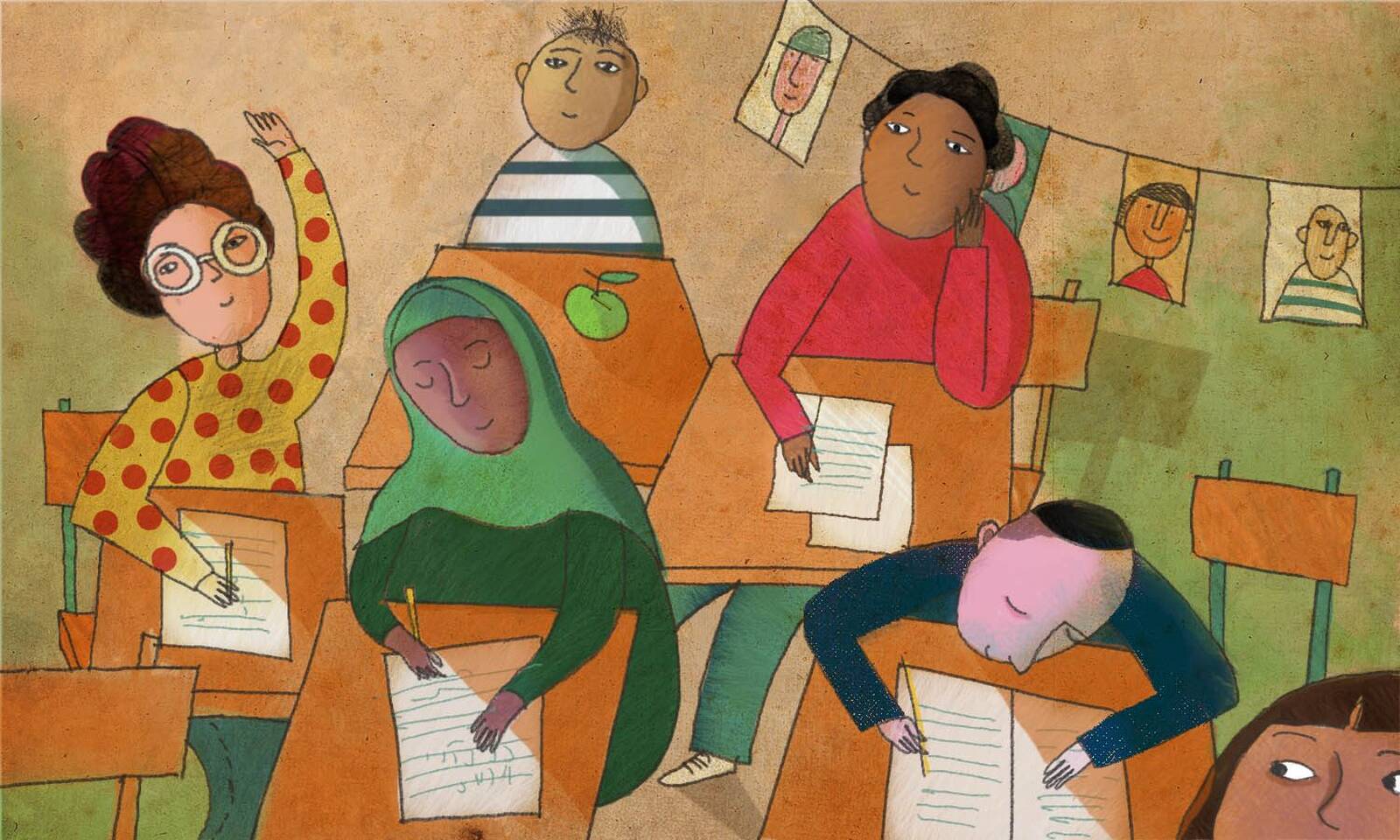Social Impact May 3, 2021
How Do Immigrant Students Affect Their Classmates’ Academic Performance?
While previous studies suggested a negative impact, new, more precise research shows these students often boost their U.S.-born peers’ test scores

Yevgenia Nayberg
Nearly one-quarter of public-school students in the U.S. are first- or second-generation immigrants. “We’re talking about huge numbers,” says Paola Sapienza, a professor of finance at Kellogg.
The strong immigrant presence in public schools has fueled a policy debate: How do first-generation immigrant students—those born outside of the U.S.—impact the school system and their fellow students? Specifically, do these kids improve or hinder their U.S.-born classmates’ academic performance?
One could imagine that immigrant students might require more school resources—for instance, if English is their second language—thus leaving less of the staff’s time, energy, or budget for other kids. On the other hand, these children may come from cultures where educational achievement is prioritized, particularly if those parents came to the U.S. in part to provide a better education for their children.
To better understand the overall picture, Sapienza and her colleagues investigated the effects of immigrant students in public schools in Florida, analyzing data on kids who attended Florida public schools between fall 2002 and spring 2012.
They found no downside to having more first-generation immigrants as classmates. In fact, some students benefited from these peers: lower-income and Black U.S.-born students scored higher on math and reading when they had more immigrant peers, while affluent and white children’s test scores stayed about the same regardless of whether a lot of immigrant kids were in their classroom.
The take-home message is that the researchers didn’t find any evidence that U.S.-born students were being negatively impacted, Sapienza says: “Immigrants generally have a positive or at worst a neutral effect.”
The Problem of White Flight
Sapienza and her coauthors aren’t the first to examine this problem. Others researchers in the U.S., Europe, and Israel also have investigated the effect of immigrant students on other kids. Most of these studies found a negative or neutral impact on native-born students’ academic performance.
But this type of research comes with two major challenges.
One is that immigrant kids are more likely to live in lower-income neighborhoods. Since family wealth is a huge factor in determining a child’s success in school, the U.S.-born children from lower-income neighborhoods are already more likely to struggle academically. A simple link between percentage of immigrant students and average test scores would suggest that schools with more immigrants do worse—but the low scores may not be due to the immigrants themselves.
The second problem is that white families tend to flee from public schools with a lot of low-income, minority students. When high-performing, affluent children end up in schools with fewer immigrants, it may seem like having a low immigrant population is good for U.S.-born kids’ test scores, even if the real cause is white flight.
Staying in the Family
While previous studies generally addressed the first concern, they didn’t have the right data to address the second. To come up with a better method, Sapienza collaborated with David Figlio at Northwestern University; Riccardo Marchingiglio, a Northwestern PhD graduate now at Analysis Group; Paola Giuliano at the University of California, Los Angeles; and Umut Ozek at the American Institutes for Research. The team took advantage of detailed data sets in Florida to control for both factors.
The records came from the Florida Department of Education and tracked K–12 public-school students enrolled from 2002–2012. The data include reading and math test scores from grades 3 to 10, as well as the country in which each child was born and the language they spoke at home. The team could therefore identify first-generation immigrant children—that is, those born outside the United States. From Florida’s Bureau of Vital Statistics, the researchers also obtained students’ birth records, which contained socioeconomic details such as the mother’s education level.
First, the team replicated the standard analysis performed in the previous literature and compared U.S.-born students in schools with fewer or more immigrants, controlling for factors such as gender and whether the child needed special-education services. In this analysis, immigrant students did appear to negatively affect U.S.-born peers’ test scores. Controlling for the school reduced the negative effect but did not fully eliminate it.
School records revealed that, on average, immigrant students had fewer serious disciplinary incidents than U.S.-born children did.
But the researchers’ data set had a key advantage: it showed which kids were siblings. This allowed the researchers to run a different, more revealing analysis.
This time, instead of comparing the performance of U.S.-born students from different families, they could compare the performance of U.S.-born children within the same family. Siblings had the same socioeconomic status but because the number of foreign-born students at a school fluctuates from year to year, each sibling was exposed to slightly different numbers of immigrant peers.
A Flipped Result
The researchers measured each sibling’s cumulative immigrant exposure—that is, the percentage of foreign-born students in that child’s grade over the course of their years in school.
Relative to the first analysis, which compared children of different socioeconomic status, “our result completely flipped,” Sapienza says. Immigrants now seemed to have a positive effect overall. Increasing a U.S.-born child’s immigrant exposure from 1 percent to 13 percent of classmates was linked to a bump in reading and math scores of 1.7 percent and 2.7 percent of a standard deviation, respectively.
How big is that bump? The difference in test scores between students with the highest cumulative exposure to immigrants (90th percentile) and students with the lowest cumulative exposure to immigrants (10th percentile) corresponds to 8.5 percent of the differences in scores between children whose mother has a high-school diploma and children whose mother has not completed high school, a medium-size effect.
The team then broke down the U.S.-born kids’ data by socioeconomic status and race. “The effect is twice as large for free or reduced priced lunch–eligible students and for Black students,” Sapienza says.
At the same time, for white students and affluent students, “there is zero effect,” she says. So it didn’t seem like immigrant children had diverted school resources away from peers.
Behavioral Benefits?
To find out why immigrants’ presence might benefit some kids, the team compared behavioral patterns across students. School records revealed that, on average, immigrant students had fewer serious disciplinary incidents—the type of infraction for which kids were typically suspended—than U.S.-born children did.
Again, the trends differed depending on the U.S.-born kids’ socioeconomic status. Affluent children had fewer incidents than immigrant peers in their schools. But among lower-income U.S.-born kids, the pattern was the opposite, and the difference was more dramatic: they had many more disciplinary reports than immigrant students did.
If immigrants at less wealthy schools are more likely than their peers to follow rules, that might partly explain why they have a beneficial effect on their classmates’ test scores, Sapienza speculates. The teacher could spend less time repeating instructions or managing disruptions, for instance, and more time teaching.
Differences in academic performance might play a role too. Affluent students had higher test scores, on average, than their immigrant classmates did, while lower-income students scored lower than their immigrant peers. So it’s possible that immigrant children in the less wealthy schools “pulled up” their lower-performing classmates. At the same time, they didn’t appear to drag down their higher-performing peers in affluent schools.
Overall, the study shows that “having diversity in schools is a good thing,” Sapienza says. “It’s particularly a good thing for kids who come from a low socioeconomic background.” And for children from wealthy households, “it’s certainly not a negative or a drawback.”
Roberta Kwok is a freelance science writer in Kirkland, Washington.
Figlio, David, Paola Giuliano, Riccardo Marchingiglio, Umut Ozek, and Paola Sapienza. “Diversity in Schools: Immigrants and the Educational Performance of U.S. Born Students.” Working paper.



